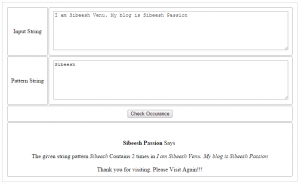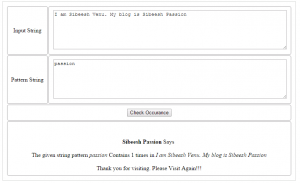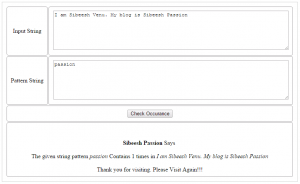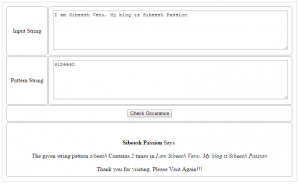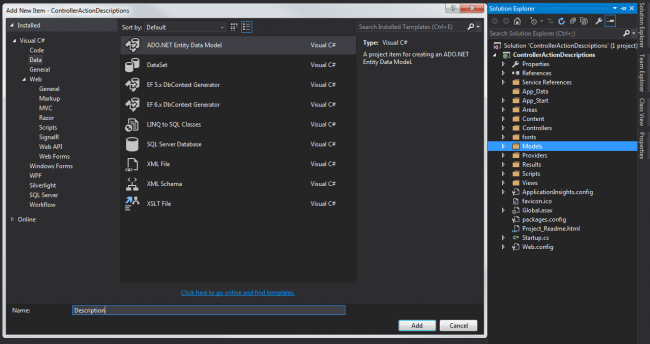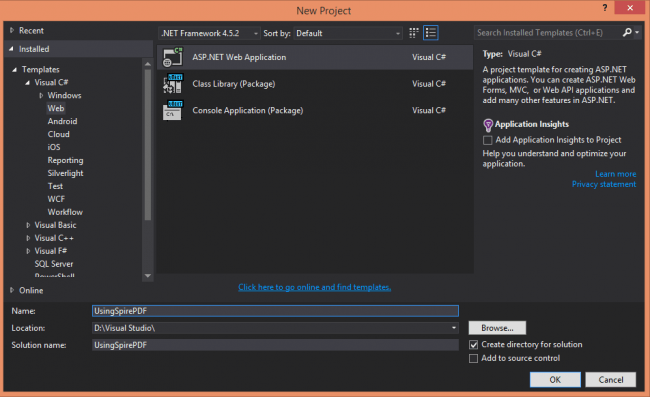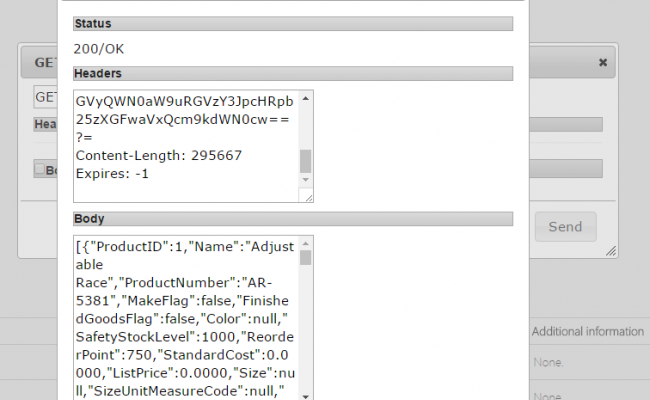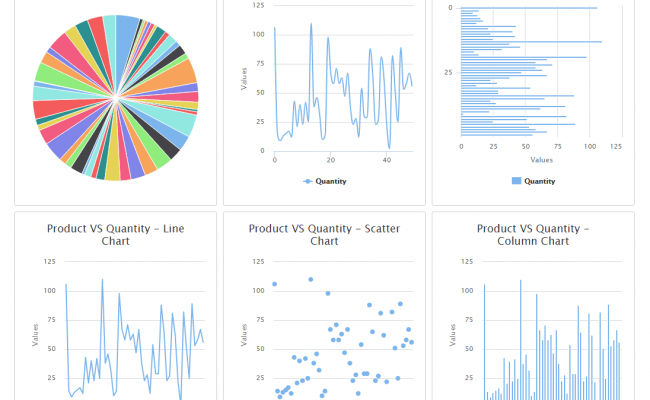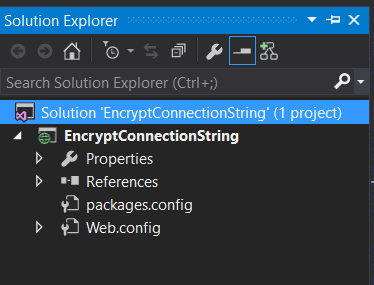Find Occurrence Of A String
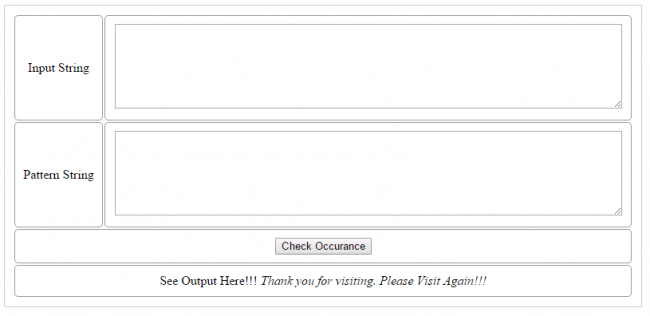
In this article you will learn the ways to find the occurrence of a string from a string, or find a sub string from a string. We are using C# language to do this demo. In times, you may have faced this requirement. And I am sure you would do that. This article is for the one who don’t know how to achieve this. We will be discussing two methods here. I hope you will like it.
See demo
Background
Today I have got a requirement of creating a function which performs some operations according to the occurrence of a string in a given string. Like, if a string pattern contains more that one time in a given string, it must do some actions and if it is just one time it should do other actions. I have done this in two ways, here I am sharing you that. I hope some one may find it is useful.
Using the code
We are going to discuss the following two ways to achieve this requirement.
We will start with a Regex class first.
To start with Regex, you need to add another namespace as given below.
[csharp]
using System.Text.RegularExpressions;
[/csharp]
Now consider we have designed our page as follows.
[html]
<div>
<table >
<tr>
<td>
<asp:Label ID="lblInputString" runat="server" Text="Input String"></asp:Label>
</td>
<td>
<textarea id="txtInputString" runat="server"></textarea>
</td>
</tr>
<tr>
<td>
<asp:Label ID="lblPattern" runat="server" Text="Pattern String"></asp:Label>
</td>
<td>
<textarea id="txtPattern" runat="server"></textarea>
</td>
</tr>
<tr>
<td colspan="2">
<asp:Button ID="btnCheckOccurance" runat="server" Text="Check Occurance" OnClick="btnCheckOccurance_Click" />
</td>
</tr>
<tr>
<td colspan="2">
<asp:Label ID="lblOutput" runat="server" Text="See Output Here!!! <i> Thank you for visiting. Please Visit Again!!! </i>"></asp:Label>
</td>
</tr>
</table>
</div>
[/html]
And Some CSS styles as follows.
[css]
<style type="text/css">
textarea {
width: 630px;
height: 100px;
}
table {
border: 1px solid #ccc;
padding: 10px;
width: 800px;
text-align:center;
}
tr {
border: 1px solid #999;
border-radius: 5px;
}
td {
border: 1px solid #999;
padding: 10px;
border-radius: 5px;
}
</style>
[/css]
If you add the above codes and CSS, your page may looks like in the preceding image.
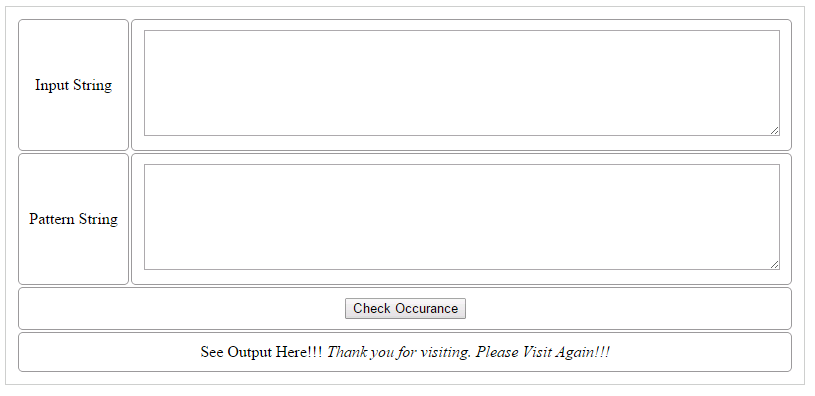
Now we will see our C# code. Please add the below lines of codes in the button click event.
[csharp]
protected void btnCheckOccurance_Click(object sender, EventArgs e)
{
int occuranceCount = 0;
//Checking Occurance
occuranceCount = Regex.Matches(txtInputString.Value.ToLower().Trim(), txtPattern.Value.ToLower().Trim()).Count;
if (occuranceCount > 0)
lblOutput.Text = "<br/><br/><b>Sibeesh Passion </b>Says <br/><br/>The given string pattern <i>" + txtPattern.Value + "</i> Contains " + occuranceCount + " times in <i>"
+ txtInputString.Value + "</i><br/><br/> Thank you for visiting. Please Visit Again!!!";
else
lblOutput.Text = "<br/><br/><b>Sibeesh Passion </b>Says <br/><br/>The given string pattern <i>" + txtPattern.Value + "</i> Is not occured s in <i>"
+ txtInputString.Value + "</i><br/><br/> Thank you for visiting. Please Visit Again!!!";
//End
}
[/csharp]
In the above code, we are finding the occurrence of a string by using a Regex.Matches function. The Regex.Matches function expects two parameters.
We are getting those two values from our texarea and pass as follows.
[csharp]
Regex.Matches(txtInputString.Value.ToLower().Trim(), txtPattern.Value.ToLower().Trim()).Count;
[/csharp]
Now if you run application, you will get output as follows.
As you can see I have given the words, “Sibeesh” and “passion” for testing, and it gave the correct number of occurrence right?
Now we will see how we can do this by Using a Custom Function.
Following in our function call.
[csharp]
occuranceCount = FindOccurrences(txtInputString.Value.ToLower().Trim(), txtPattern.Value.ToLower().Trim());
[/csharp]
And please find the function body below.
[csharp]
#region FindOccurrences
/// <summary>
/// This method is used to get the Count of Occurrences of a string in a string
/// </summary>
/// <param name="InputString"></param>
/// <param name="patternString"></param>
/// <returns>Int</returns>
public int FindOccurrences(string InputString, string patternString)
{
// Here we are looping through InputString
int intCount = 0;
int i = 0;
while ((i = InputString.IndexOf(patternString, i)) != -1)
{
i += patternString.Length;
intCount++;
}
return intCount;
}
#endregion
[/csharp]
Now if your run you will get the same output as we got by using a Regex function.
Now we will see our complete codes.
Complete Code
Default.aspx.cs
[csharp]
using System;
using System.Collections.Generic;
using System.Linq;
using System.Text.RegularExpressions;
using System.Web;
using System.Web.UI;
using System.Web.UI.WebControls;
public partial class _Default : System.Web.UI.Page
{
protected void Page_Load(object sender, EventArgs e)
{
}
protected void btnCheckOccurance_Click(object sender, EventArgs e)
{
int occuranceCount = 0;
//Checking Occurance
//occuranceCount = Regex.Matches(txtInputString.Value.ToLower().Trim(), txtPattern.Value.ToLower().Trim()).Count;
occuranceCount = FindOccurrences(txtInputString.Value.ToLower().Trim(), txtPattern.Value.ToLower().Trim());
if (occuranceCount > 0)
lblOutput.Text = "<br/><br/><b>Sibeesh Passion </b>Says <br/><br/>The given string pattern <i>" + txtPattern.Value + "</i> Contains " + occuranceCount + " times in <i>"
+ txtInputString.Value + "</i><br/><br/> Thank you for visiting. Please Visit Again!!!";
else
lblOutput.Text = "<br/><br/><b>Sibeesh Passion </b>Says <br/><br/>The given string pattern <i>" + txtPattern.Value + "</i> Is not occured s in <i>"
+ txtInputString.Value + "</i><br/><br/> Thank you for visiting. Please Visit Again!!!";
//End
}
#region FindOccurrences
/// <summary>
/// This method is used to get the Count of Occurrences of a string in a string
/// </summary>
/// <param name="InputString"></param>
/// <param name="patternString"></param>
/// <returns>Int</returns>
public int FindOccurrences(string InputString, string patternString)
{
// Here we are looping through InputString
int intCount = 0;
int i = 0;
while ((i = InputString.IndexOf(patternString, i)) != -1)
{
i += patternString.Length;
intCount++;
}
return intCount;
}
#endregion
}
[/csharp]
Default.aspx
[html]
<%@ Page Language="C#" AutoEventWireup="true" CodeFile="Default.aspx.cs" Inherits="_Default" %>
<!DOCTYPE html>
<html xmlns="http://www.w3.org/1999/xhtml">
<head runat="server">
<title>Find Occurrence of String,Find String Form String,Regex,String Contains Substring – Sibeesh Passion</title>
<style type="text/css">
textarea {
width: 630px;
height: 100px;
}
table {
border: 1px solid #ccc;
padding: 10px;
width: 800px;
text-align:center;
}
tr {
border: 1px solid #999;
border-radius: 5px;
}
td {
border: 1px solid #999;
padding: 10px;
border-radius: 5px;
}
</style>
</head>
<body>
<form id="form1" runat="server">
<div>
<table >
<tr>
<td>
<asp:Label ID="lblInputString" runat="server" Text="Input String"></asp:Label>
</td>
<td>
<textarea id="txtInputString" runat="server"></textarea>
</td>
</tr>
<tr>
<td>
<asp:Label ID="lblPattern" runat="server" Text="Pattern String"></asp:Label>
</td>
<td>
<textarea id="txtPattern" runat="server"></textarea>
</td>
</tr>
<tr>
<td colspan="2">
<asp:Button ID="btnCheckOccurance" runat="server" Text="Check Occurance" OnClick="btnCheckOccurance_Click" />
</td>
</tr>
<tr>
<td colspan="2">
<asp:Label ID="lblOutput" runat="server" Text="See Output Here!!! <i> Thank you for visiting. Please Visit Again!!! </i>"></asp:Label>
</td>
</tr>
</table>
</div>
</form>
</body>
</html>
[/html]
Validation
Now if you want you can add some basic validation to your code in server side and client side. I will always recommend you to do both validation.
Server Side
[csharp]
if (txtInputString.Value.ToLower().Trim() != "" && txtPattern.Value.ToLower().Trim() != "")
{
}
[/csharp]
Place the button click event code inside of this if condition.
Client Side
Add a Jquery reference
[js]
<script src="jquery-2.0.2.min.js"></script>
[/js]
And add the below scripts.
[js]
<script>
$(document).ready(function () {
$(‘#btnCheckOccurance’).click(function () {
if ($(‘#txtInputString’).val() == "" || $(‘#txtPattern’).val() == "") {
alert(‘Values can not be empty’);
return false;
}
});
});
</script>
[/js]
Conclusion
I hope someone found this article useful. Please share me your valuable thoughts and comments. Your feedback is always welcomed.
Thanks in advance. Happy coding!
Kindest Regards
Sibeesh Venu

